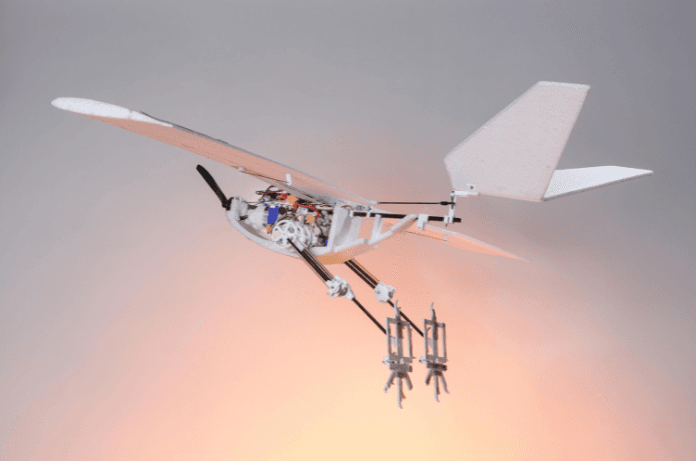When you hear the phrase “as the crow flies,” you probably picture the most direct, unobstructed path between two points. For centuries, we have marveled at birds’ ability to traverse the skies effortlessly and transition seamlessly between air and land. While early aviation pioneers like the Wright brothers found inspiration in avian flight, modern planes are still no match for the agility and versatility of actual birds. But what if drones could achieve this level of adaptability? Enter RAVEN short for Robotic Avian-Inspired Vehicle for Multiple Environments a cutting-edge innovation from the Laboratory of Intelligent Systems (LIS) at the École Polytechnique Fédérale de Lausanne (EPFL), led by Dario Floreano.
Inspired by birds such as ravens and crows, RAVEN is a drone that doesn’t just fly; it walks, hops, jumps, and launches itself into the air from confined spaces a capability that could revolutionize fields from delivery services to disaster relief.
Birds as the Blueprint
“We owe the dream of flight to birds, but our aircraft are still far from what birds can achieve,” says Won Dong Shin, a PhD student at LIS. Birds are nature’s multitaskers: they walk, run, perch, and take off without needing a runway. For robotics, replicating this adaptability has been a challenge.
To tackle this, Shin and his team closely studied the anatomy and behavior of birds, particularly the crows on EPFL’s campus. The goal was to design a set of multifunctional legs for a fixed-wing drone that could balance complexity with weight efficiency. After extensive mathematical modeling, computer simulations, and real-world testing, the team crafted legs that weigh just 0.62 kilograms and allow RAVEN to navigate diverse terrains and launch into flight.
The legs are an engineering marvel. To maintain balance and minimize weight, the heaviest components are positioned close to the drone’s body. RAVEN‘s legs are equipped with a combination of springs and motors, mirroring the way avian tendons and muscles work. The feet — lightweight yet sturdy — consist of two articulated structures that support a range of movements, including walking, hopping, and jumping.
The Genius Behind RAVEN’s Legs
Designing robotic legs that mirror bird functionality was no small feat. “Translating avian legs and feet into a lightweight robotic system presented us with design, integration, and control problems that birds have solved elegantly over the course of evolution,” explains Dario Floreano.
The team’s solution resulted in RAVEN becoming the most multimodal winged drone to date. This breakthrough not only advances drone technology but also sheds light on the energetic efficiency of jumping take-offs both in birds and drones. Their findings were so significant that they were published in Nature.
Walking, Hopping, and Taking Off: The RAVEN Advantage
Unlike traditional drones that require clear, open spaces for take-off and landing, RAVEN thrives in complex environments. The drone’s ability to walk and jump makes it perfect for places where winged drones typically struggle, such as forests, rubble-filled disaster zones, or tight urban spaces.
During testing, RAVEN demonstrated its agility by walking over uneven terrain, hopping gaps, and jumping onto surfaces as high as 26 centimeters. The team also tested various flight initiation techniques including standing and falling take-offs and found that jumping into flight was the most energy-efficient method.
Collaboration in Action: Combining Robotics and Biomechanics
To develop RAVEN, the LIS team collaborated with experts from other fields. They worked closely with Auke Ijspeert from EPFL’s BioRobotics Lab and Monica Daley from the Neuromechanics Lab at the University of California, Irvine. This multidisciplinary approach allowed them to adapt bird biomechanics to robotic locomotion successfully.
The results offer a significant leap forward: a lightweight drone that can maneuver rough terrains and take off autonomously from confined spaces. This opens up a world of possibilities for real-world applications.
Game-Changing Applications for Drones
RAVEN’s versatility has the potential to transform several industries:
- Disaster Relief: In disaster zones filled with debris and obstructions, RAVEN could deliver critical supplies or perform search-and-rescue missions where conventional drones can’t operate.
- Delivery Services: Imagine a drone delivering packages to your doorstep by landing, walking upstairs, and then taking off again no need for clear landing zones.
- Infrastructure Inspection: Inspecting structures like bridges or power lines often requires navigating through tight or hazardous spaces. RAVEN can perch, walk, and take off to gather detailed data.
Looking Ahead: From RAVEN to the Future of Robotics
While RAVEN represents a significant step forward, the journey is just beginning. “Avian wings are like the front legs of quadrupeds, but we still know little about the coordination of legs and wings in birds let alone drones,” says Dario Floreano. This project is a critical first step toward understanding these principles and applying them to agile, efficient drones.
The EPFL team is already refining RAVEN’s design and control systems to enable landing in even more varied environments. The possibilities are vast, and each improvement brings us closer to a future where drones can seamlessly transition between flying and walking just like birds.
A Glimpse into the Future: The Call to Innovate
What RAVEN showcases is more than just technological prowess; it’s a testament to the power of nature-inspired engineering. By studying and mimicking birds, scientists and engineers are unlocking new potential in robotics that could change how we interact with the world around us.
As Dario Floreano aptly puts it, “These results represent just a first step.” The future holds even more promise, and with continued innovation, drones like RAVEN could redefine mobility across air and land.
Ready to Witness the Future of Flight?
Innovation doesn’t stop here. As RAVEN continues to evolve, its potential applications will expand. From delivering aid in disasters to revolutionizing logistics and inspections, this bird-inspired drone is just the beginning.

